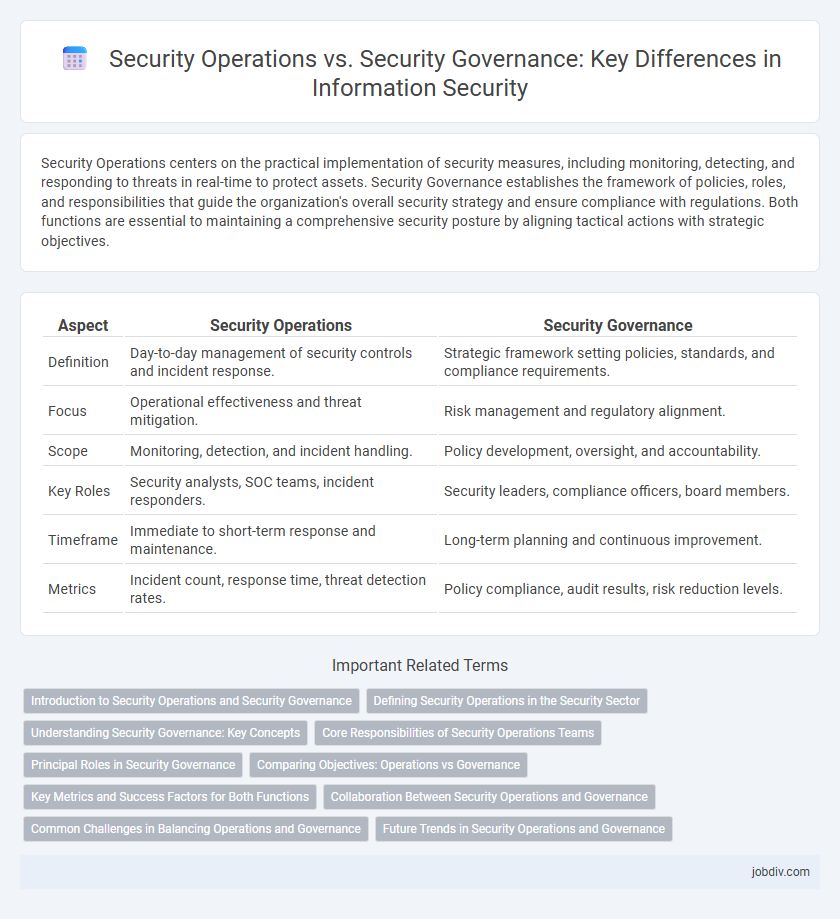Security Operations centers on the practical implementation of security measures, including monitoring, detecting, and responding to threats in real-time to protect assets. Security Governance establishes the framework of policies, roles, and responsibilities that guide the organization's overall security strategy and ensure compliance with regulations. Both functions are essential to maintaining a comprehensive security posture by aligning tactical actions with strategic objectives.
Table of Comparison
| Aspect | Security Operations | Security Governance |
|---|---|---|
| Definition | Day-to-day management of security controls and incident response. | Strategic framework setting policies, standards, and compliance requirements. |
| Focus | Operational effectiveness and threat mitigation. | Risk management and regulatory alignment. |
| Scope | Monitoring, detection, and incident handling. | Policy development, oversight, and accountability. |
| Key Roles | Security analysts, SOC teams, incident responders. | Security leaders, compliance officers, board members. |
| Timeframe | Immediate to short-term response and maintenance. | Long-term planning and continuous improvement. |
| Metrics | Incident count, response time, threat detection rates. | Policy compliance, audit results, risk reduction levels. |
Introduction to Security Operations and Security Governance
Security Operations encompass the continuous processes and technologies dedicated to detecting, responding to, and mitigating cyber threats in real-time, ensuring organizational resilience. Security Governance establishes the framework of policies, procedures, and roles that define the strategic direction and accountability for managing cybersecurity risks. Together, Security Operations and Security Governance enable organizations to maintain a robust security posture through effective risk management and operational execution.
Defining Security Operations in the Security Sector
Security Operations in the security sector refers to the continuous management and monitoring of security systems to detect, prevent, and respond to threats in real time. It encompasses activities like incident detection, threat analysis, asset protection, and response coordination to maintain organizational safety. Effective Security Operations rely on advanced tools such as Security Information and Event Management (SIEM) systems and Security Orchestration, Automation, and Response (SOAR) platforms.
Understanding Security Governance: Key Concepts
Security governance establishes the framework of policies, procedures, and controls that guide an organization's overall security strategy and risk management. It ensures alignment of security objectives with business goals, compliance requirements, and stakeholder expectations through structured oversight and accountability mechanisms. Effective security governance enables consistent decision-making, resource allocation, and performance measurement to protect critical assets and maintain organizational resilience.
Core Responsibilities of Security Operations Teams
Security Operations teams focus on real-time threat detection, incident response, and continuous monitoring to protect organizational assets and maintain system integrity. They manage security tools, analyze alerts, and implement mitigation strategies to minimize risks and operational disruptions. Their core responsibilities include vulnerability management, log analysis, and enforcing security policies to ensure robust defense against cyber threats.
Principal Roles in Security Governance
Security governance establishes the overarching policies, frameworks, and strategic direction to manage cybersecurity risks, ensuring alignment with organizational objectives and regulatory requirements. Principal roles in security governance include the Chief Information Security Officer (CISO), who oversees policy development and risk management, and the Security Governance Committee, responsible for monitoring compliance and evaluating security effectiveness. These roles focus on decision-making authority, stakeholder communication, and continuous improvement of the security posture through governance frameworks like COBIT or ISO/IEC 27014.
Comparing Objectives: Operations vs Governance
Security Operations prioritize real-time monitoring, incident response, and threat mitigation to protect organizational assets from immediate risks. Security Governance establishes policies, frameworks, and compliance standards to ensure long-term alignment of security initiatives with business objectives and regulatory requirements. Together, these functions balance tactical defense efforts with strategic oversight to create a comprehensive security posture.
Key Metrics and Success Factors for Both Functions
Security Operations prioritize metrics such as incident response time, mean time to detect (MTTD), mean time to recover (MTTR), and the number of security incidents resolved, which directly impact real-time threat mitigation and operational resilience. Security Governance focuses on success factors including compliance audit results, policy adherence rates, risk assessment coverage, and alignment with regulatory frameworks like GDPR and NIST standards, ensuring overall security strategy and risk management effectiveness. Both functions require continuous measurement and improvement through key performance indicators (KPIs) to achieve a holistic cybersecurity posture.
Collaboration Between Security Operations and Governance
Collaboration between Security Operations and Security Governance is essential to align tactical response with strategic security policies, ensuring real-time threat mitigation supports compliance requirements. Effective communication channels and integrated workflows enable seamless information sharing, enhancing incident detection and risk management across the organization. This synergy strengthens overall security posture by bridging operational activities with governance frameworks and regulatory standards.
Common Challenges in Balancing Operations and Governance
Security operations and security governance often face the challenge of aligning real-time threat detection with long-term strategic policies. Operational teams prioritize incident response and vulnerability management, whereas governance focuses on compliance, risk assessments, and policy enforcement, creating potential gaps in communication and resource allocation. Bridging this divide requires integrated frameworks that ensure continuous monitoring supports governance mandates without compromising agility in threat mitigation.
Future Trends in Security Operations and Governance
Security operations are increasingly integrated with artificial intelligence and machine learning to enhance threat detection and response times, while security governance evolves through adaptive frameworks that enforce compliance in dynamic regulatory landscapes. Emphasis on zero trust architectures and automated policy enforcement drives the convergence of operational efficiency and governance accountability. Future trends highlight the growing role of continuous risk assessment and cross-functional collaboration to preempt sophisticated cyber threats and ensure resilient security postures.
Security Operations vs Security Governance Infographic

 jobdiv.com
jobdiv.com